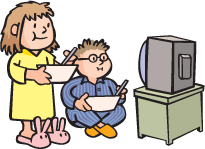Boston Children's Museum
308 Congress Street, Boston, MA 02210
617-426-6500
© Boston Children’s Museum 2025
Website Design by JackrabbitMost children only have a basic understanding of their own bodies, and they often have little choice about what they are served at meals. At the same time, these children are just becoming acquainted with a variety of foods. The more opportunities children have to think about what they eat, be curious and adventurous in trying new foods and begin to take responsibility for their own lifestyle choices, the more likely they are to make healthful choices when they do get to decide what fuel they are putting into their bodies. In this activity, children will learn how to read about the nutritional information for some of the breakfast cereals they like to eat. Learning to read these labels is one of the most helpful tools we have in gaining control of our eating habits.
It may take some time to gather the breakfast cereal boxes. 5-10 boxes should be enough, and make sure to collect a range of different kinds, from some that are sweet to some that are not. Some suggested brands are “Froot Loops”, “Frosted Mini Wheats”, “Crispix”, “Special K” and “Raisin Bran”.

Ask your students what some of their favorite breakfast foods are. If they mention cereal, ask them to brainstorm a list of the kinds of breakfast cereal they like to eat. Record this list on a chalkboard or a piece of chart paper. Which of these cereals do kids think have lots of sugar and which have only a little? Record the cereals that they guess are in these 2 groups. Finally, show them the boxes of cereal that you have gathered and ask them to write these brand names down on a piece of paper.
Using the boxes of breakfast cereal you’ve been shown, can you guess which cereals have the most sugar in them and which have the least?
Did each team agree on which cereals were sweetest and which were the least sweet? How could they find out the answer? Ask for some different ideas. Hopefully, someone suggests reading the nutritional label. If no student suggests this, point out the label on 1 of the boxes and ask if they have ever noticed it before. What does this label tell us?
Have students look at the labels of the breakfast cereals and try to figure out how much sugar is in a serving of each of the cereals. They should take turns passing the boxes from team to team, each writing down the amount of sugar next to the corresponding cereal name on their piece of paper. Ask each team to rewrite the order on their piece of paper of the cereals with the least sugar to the cereals with the most sugar. Is the order different than they had first guessed? Did any of the results surprise them?